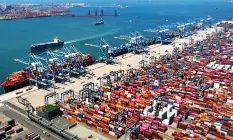September 22, 2025
Foreign investments have surged to a three-month high, even as China reduces its holdings, highlighting shifting global capital flows and investor confidence in international markets.

Global capital flows are experiencing notable shifts as foreign holdings climb to a three-month high, despite China’s ongoing reduction of its investments. Analysts indicate that this trend reflects both strong investor confidence and changing priorities among major international investors.
Overview of Foreign Holdings Foreign holdings, which include investments in stocks, bonds, and other financial assets, have increased consistently for the third consecutive month. This rise is being driven by factors such as:
Increased demand for safe-haven assets amid global economic uncertainty
Optimism in developed markets, particularly in the US, UK, and Europe
Corporate and sovereign debt investments offering stable returns
China’s Reduction in Holdings While foreign investors are increasing positions, China has been reducing its holdings in various international assets. This move is seen as part of Beijing’s strategy to rebalance foreign investments, manage capital outflows, and focus on domestic economic priorities. Analysts note that China’s actions could affect global market sentiment, particularly in sectors heavily influenced by Chinese investment.
Market Implications
For Global Investors: The surge in foreign holdings signals confidence in developed markets and potentially higher returns on international assets.
For Emerging Markets: China’s selling activity may create short-term volatility, impacting currencies, equities, and bonds in emerging economies.
For Policy Makers: Governments and central banks may need to monitor cross-border capital flows closely to maintain market stability and manage exchange rates.
Economic Drivers Several factors are contributing to the recent surge:
Strong Corporate Earnings: Companies in developed markets have reported better-than-expected results, attracting foreign capital.
Low-Interest Rates in Certain Regions: Investors seek higher yields abroad, driving cross-border investment.
Diversification Strategies: Portfolio managers are reallocating assets to reduce risk and optimize returns.
Challenges and Risks
Geopolitical Tensions: Trade disputes, sanctions, and political uncertainty could impact foreign holdings.
Currency Fluctuations: Movements in exchange rates may affect returns on foreign investments.
Global Economic Slowdown: Concerns over slowing growth in key economies could temper investor enthusiasm.
Future Outlook The trend of rising foreign holdings suggests continued confidence in international markets, while China’s strategic sales indicate ongoing portfolio adjustments. Analysts expect that capital flows will remain dynamic, with foreign investors balancing growth opportunities with risk management considerations.
Conclusion Foreign holdings hitting a three-month high, despite China’s reductions, highlights the complex interplay of global capital flows, investor confidence, and strategic national investment decisions. Market participants will continue to watch these trends for signals of stability, opportunity, and potential volatility in international financial markets.